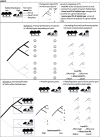Disturbed habitats locally reduce the signal of deep evolutionary history in functional traits of plants
- PMID: 34455590
- PMCID: PMC9292768
- DOI: 10.1111/nph.17705
Disturbed habitats locally reduce the signal of deep evolutionary history in functional traits of plants
Abstract
The functioning of present ecosystems reflects deep evolutionary history of locally cooccurring species if their functional traits show high phylogenetic signal (PS). However, we do not understand what drives local PS. We hypothesize that local PS is high in undisturbed and stressful habitats, either due to ongoing local assembly of species that maintained ancestral traits, or to past evolutionary maintenance of ancestral traits within habitat species-pools, or to both. We quantified PS and diversity of 10 traits within 6704 local plant communities across 38 Dutch habitat types differing in disturbance or stress. Mean local PS varied 50-fold among habitat types, often independently of phylogenetic or trait diversity. Mean local PS decreased with disturbance but showed no consistent relationship to stress. Mean local PS exceeded species-pool PS, reflecting nonrandom subsampling from the pool. Disturbance or stress related more strongly to mean local than to species-pool PS. Disturbed habitats harbour species with evolutionary divergent trait values, probably driven by ongoing, local assembly of species: environmental fluctuations might maintain different trait values within lineages through an evolutionary storage effect. If functional traits do not reflect phylogeny, ecosystem functioning might not be contingent on the presence of particular lineages, and lineages might establish evolutionarily novel interactions.
Keywords: community assembly; disturbance and stress; functional diversity; niche conservatism; phylogenetic diversity; phylogenetic signal; species-pool; trait evolution.
© 2021 The Authors. New Phytologist © 2021 New Phytologist Foundation.
Figures




Similar articles
-
Why phylogenetic signal of traits is important in ecosystems: uniformity of a plant trait increases soil fauna, but only in a phylogenetically uniform vegetation.Oecologia. 2023 May;202(1):175-191. doi: 10.1007/s00442-023-05384-z. Epub 2023 May 18. Oecologia. 2023. PMID: 37204497 Free PMC article.
-
Disturbance alters the phylogenetic composition and structure of plant communities in an old field system.PLoS One. 2009 Sep 18;4(9):e7071. doi: 10.1371/journal.pone.0007071. PLoS One. 2009. PMID: 19763265 Free PMC article.
-
Less lineages - more trait variation: phylogenetically clustered plant communities are functionally more diverse.Ecol Lett. 2008 Aug;11(8):809-19. doi: 10.1111/j.1461-0248.2008.01189.x. Ecol Lett. 2008. PMID: 18445034
-
Integrating species traits into species pools.Ecology. 2018 Jun;99(6):1265-1276. doi: 10.1002/ecy.2220. Ecology. 2018. PMID: 29569239 Review.
-
Measuring biodiversity to explain community assembly: a unified approach.Biol Rev Camb Philos Soc. 2011 Nov;86(4):792-812. doi: 10.1111/j.1469-185X.2010.00171.x. Epub 2010 Dec 14. Biol Rev Camb Philos Soc. 2011. PMID: 21155964 Review.
Cited by
-
Why phylogenetic signal of traits is important in ecosystems: uniformity of a plant trait increases soil fauna, but only in a phylogenetically uniform vegetation.Oecologia. 2023 May;202(1):175-191. doi: 10.1007/s00442-023-05384-z. Epub 2023 May 18. Oecologia. 2023. PMID: 37204497 Free PMC article.
-
Offspring may succeed well next to their relatives, but it needs particular traits.Ann Bot. 2025 Feb 19;135(3):495-514. doi: 10.1093/aob/mcae177. Ann Bot. 2025. PMID: 39377181
References
-
- Ackerly DD. 2003. Community assembly, niche conservatism, and adaptive evolution in changing environments. International Journal of Plant Sciences 164: S165–S184.
-
- Ackerly DD. 2004. Adaptation, niche conservatism, and convergence: comparative studies of leaf evolution in the California chaparral. American Naturalist 163: 654–671. - PubMed
-
- Bartish IV, Hennekens S, Aidoud A, Hennion F, Prinzing A. 2010. Species pools along contemporary environmental gradients represent different levels of diversification. Journal of Biogeography 37: 2317–2331.
-
- Bartish IV, Ozinga WA, Bartish MI, Wamelink GWW, Hennekens SM, Prinzing A. 2016. Different habitats within a region contain evolutionary heritage from different epochs depending on the abiotic environment. Global Ecology and Biogeography 25: 274–285.
Publication types
MeSH terms
LinkOut - more resources
Full Text Sources
Miscellaneous

